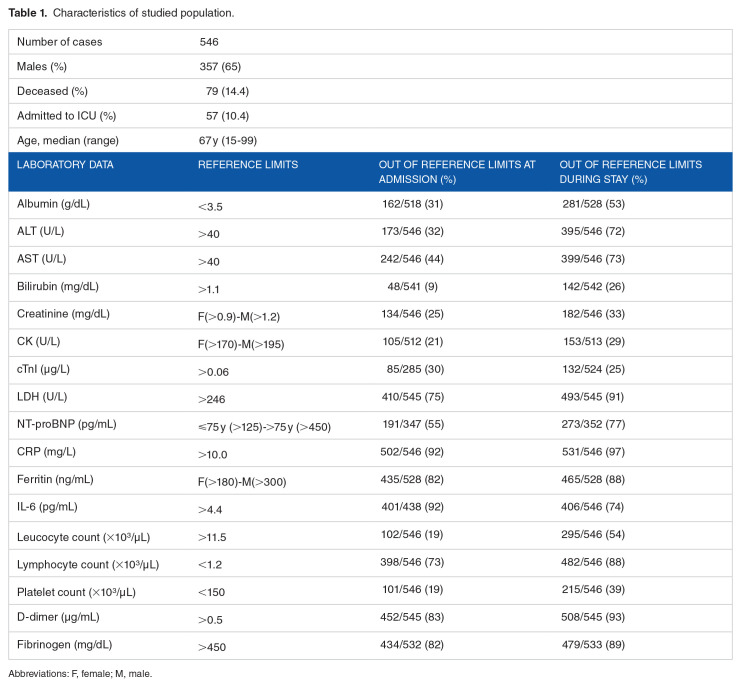马德里一项与COVID-19住院患者预后不良相关的IL-6和其他生物标志物
IF 2.6
Q2 MEDICINE, RESEARCH & EXPERIMENTAL
引用次数: 16
摘要
目的:已经发表了几篇关于生物标志物与2019冠状病毒病(COVID-19)严重程度或致命结局相关的预后价值的论文。西班牙是收集数据时该病发病率第二高的欧洲国家,但很少有研究同时包括实验室参数和临床参数。我们的目的是研究一系列生物标志物与马德里自治区(西班牙)一家医院重症监护和死亡的关系,特别关注IL-6,因为它在与疾病预后较差相关的全身炎症反应中起作用。方法:收集546例新冠肺炎住院患者资料。除其他生化和血液学参数外,所有患者均有IL-6结果。采用Mann-Whitney分析研究两组(ICU与非ICU、死亡与幸存者)所选参数中位数的差异。使用Cox比例风险回归模型研究预测死亡的自变量。结果:在单因素分析中,较高的年龄和血中ALT、肌酐、CK、cTnI、LDH、NT-proBNP、CRP、IL-6、白细胞计数和d -二聚体浓度以及较低的血中白蛋白浓度和淋巴细胞计数与死亡率相关。在多变量分析中,年龄、LDH、IL-6和淋巴细胞计数仍与死亡相关。结论:年龄、LDH、IL-6和淋巴细胞计数作为死亡的独立预测因子,可用于建立更积极的COVID-19患者治疗方法。本文章由计算机程序翻译,如有差异,请以英文原文为准。



IL-6 and Other Biomarkers associated with Poor Prognosis in a Cohort of Hospitalized Patients with COVID-19 in Madrid.
Objectives: There are several published works on the prognostic value of biomarkers in relation to the severity or fatal outcome of coronavirus disease 2019 (COVID-19). In Spain, the second European country in incidence of the disease at the time of data collection, there are few studies that include both laboratory parameters and clinical parameters. Our aim is to study the relationship of a wide series of biomarkers with admission to intensive care and death in a hospital in the Autonomous Community of Madrid (Spain), with special attention to IL-6 due to its role in the systemic inflammatory response associated with a worse prognosis of the disease. Methods: Data were collected from 546 hospitalized patients with COVID-19. All of them had IL-6 results, in addition to other biochemical and haematological parameters. The difference of the medians for the selected parameters between the groups (ICU vs non-ICU, dead vs survivors) was studied using a Mann-Whitney analysis. The independent variables that predicted death were studied using a Cox proportional hazard regression model. Results: Higher age and blood concentrations of ALT, creatinine, CK, cTnI, LDH, NT-proBNP, CRP, IL-6, leucocyte count and D-dimer together with lower blood concentrations of albumin and lymphocyte count were associated with mortality in univariate analysis. Age, LDH, IL-6 and lymphocyte count remained associated with death in multivariate analysis. Conclusions: Age, LDH, IL-6 and lymphocyte count, as independent predictors of death, could be used to establish more aggressive therapies in COVID-19 patients.
求助全文
通过发布文献求助,成功后即可免费获取论文全文。
去求助
来源期刊

Biomarker Insights
MEDICINE, RESEARCH & EXPERIMENTAL-
CiteScore
6.00
自引率
0.00%
发文量
26
审稿时长
8 weeks
期刊介绍:
An open access, peer reviewed electronic journal that covers all aspects of biomarker research and clinical applications.
 求助内容:
求助内容: 应助结果提醒方式:
应助结果提醒方式:


